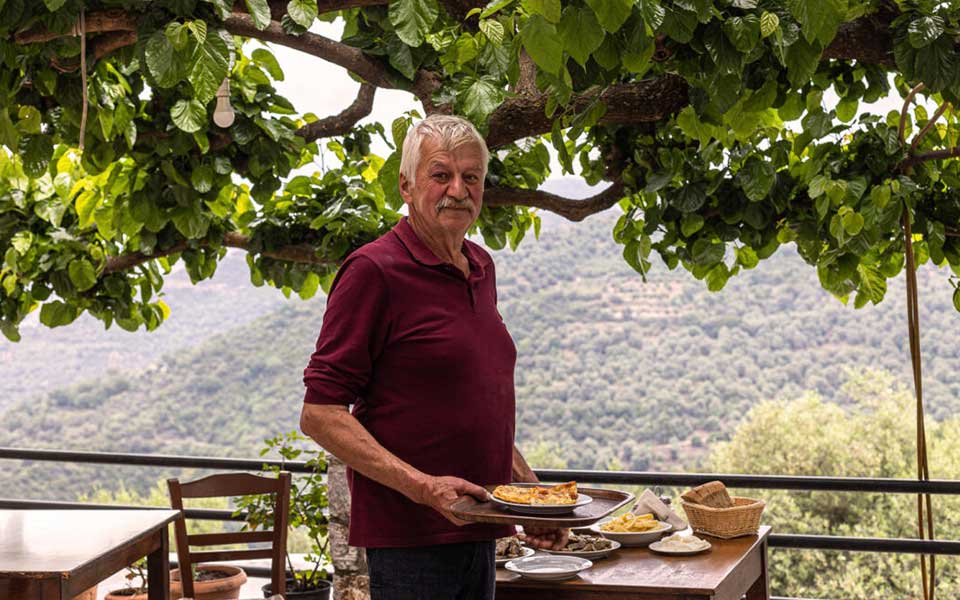“Where does the name ‘Lamprogiorgis’ come from?” I asked Giorgos Mavridakis upon arriving at his kafeneio in Karanos on the Omalos Plateau, in the heart of the regional unit of Hania on the island of Crete.
“This kafeneio belonged to my grandfather, Charalambos Mavridakis,” he replied. “After that, my father, Michalis, also known as Lampromichalis, meaning ‘the son of Lambis or Charalambos,’ took over. So, I am called Lamprogiorgis, meaning Giorgos, the descendant of Charalambos,” he continued, all while serving Greek coffee brewed on a gas stove. “I took over the kafeneio in 1980, right after I was discharged from the army.”
He is too young to remember when his grandfather ran the place, but he has vivid memories of the days when his father was in charge, and it also served as a grocery store. “We stocked sardines, flour, and different kinds of dried beans. I remember my father served pan-fried lamb sweetbreads as meze every Saturday, after the animals were slaughtered, and the customers would eat them standing at the counter with a glass of wine. The village didn’t have electricity back then, and when they slaughtered an animal, they had to cook the innards somehow because they couldn’t preserve them otherwise. My father cooked well, and gradually he started cooking other meat dishes, too, such as boiled meat with rice pilaf, kokkinisto (tomato beef stew), tsigariasto (traditional seared meat stew), and lamb chops. That’s how I continued it; a few meze dishes, kafeneio-style.”
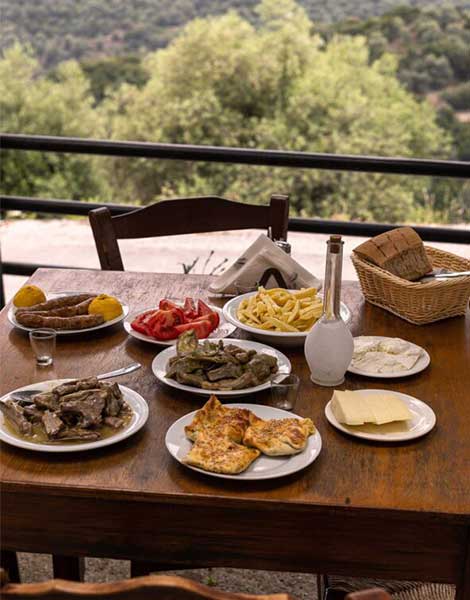
© Christina Georgiadou
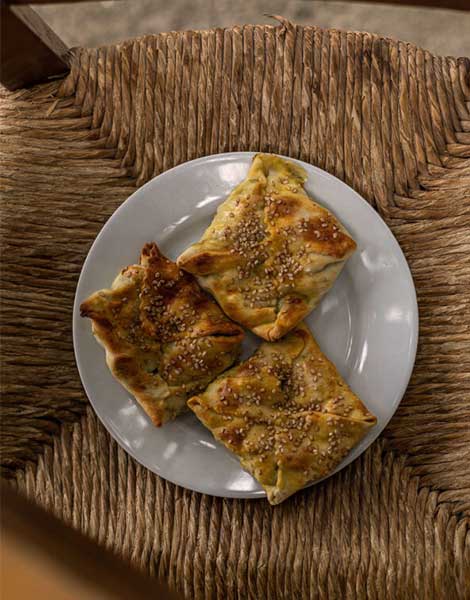
© Christina Georgiadou
We sat on the balcony, in the ample shade of a mulberry tree, enjoying breathtaking views of the gorge of Boriano and the sloping flanks of Kydoni Gorge, covered in mountain olive and kermes oak trees. Lamprogiorgis brought out dishes of tsigariasto, pan-fried pickled sausage, fresh artichoke beans, fries, and mini savory parcels stuffed with wild greens, all of which he serves throughout the summer. However, his most renowned dish, the highlight of our meal that day, is his pilaf.
He first prepares a strong broth, using nearly three kilograms of lamb, and in it he boils a beautiful yellowish rice, which draws extra flavor from the lamb fat. All the meat he serves, except for the sausages, is sourced from the village. The cheeses are from the Balantinos Dairy in Hania, the vegetables are all from Lamprogiorgis’ own garden, and the wild greens are foraged by hand from the gorge. During the summer, meat dishes are prepared only by request when a group is planning to visit. “Our work is mainly seasonal,” Lamprogiorgis explained. “It’s a mountain village and visitors, mainly from the city of Hania, only come up here during the winter and spring months, especially when it rains or snows because they have views of the gorges of both Boriano and Kydoni stretching out in front of them. They enjoy some wine and eat some meze, whatever I happen to have prepared on the day. In the summer, they prefer the beaches and our business slows down. However, if a group places an order, we prepare everything. Hikers, especially groups from mountaineering clubs, often pass by on their way to Samaria Gorge, which is famous,” he added.
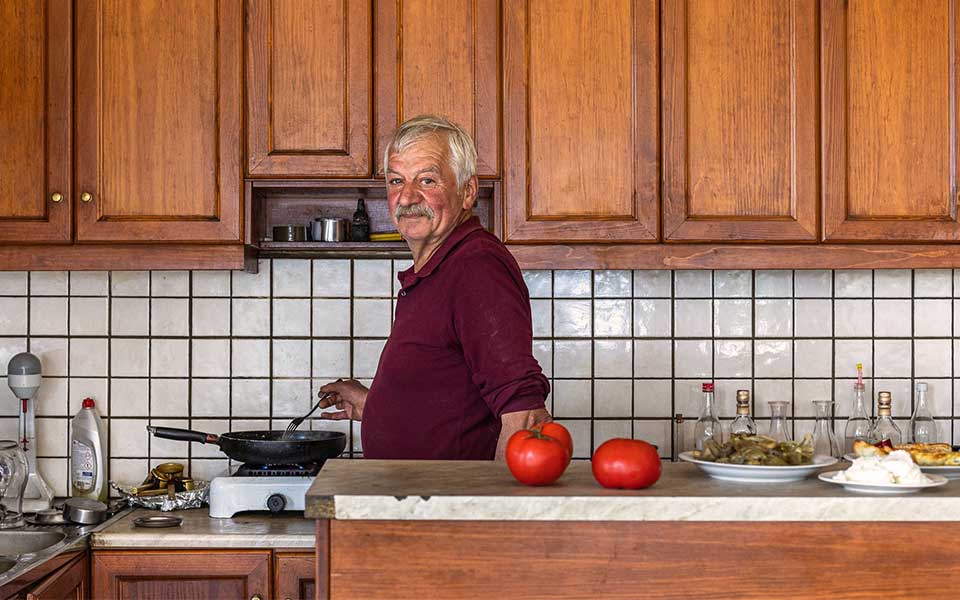
© Christina Georgiadou
The kafeneio has regular customers, mainly hikers from abroad following the trail that traverses the two gorges, and a stop at Lamprogiorgis is exactly what they need to enjoy some meze, spectacular views and absolute tranquility. “The foreigners come every year! You should see the Germans and the Dutch eating the lamb chops! People from Hania, the city, used to come here. They liked the meze, talked about it to their friends, and that’s how people found out about it, through word of mouth. It’s the best advertising! These days, we’re consistently busy with both locals and foreigners. The locals who come daily are few, around fifteen. They come only in the evening to play cards, have their wine or a shot of tsikoudia, and enjoy some meze. In the winter, there are more of them; they gather here after the olive harvest.”
The village has suffered the fate of most mountain settlements; it empties further, year by year. About 80 residents remain, and most of them are getting on in years. Lamprogiorgis himself has three children; they went away to university and now live in Athens. They only come in the summer. On the day that I was there, he welcomed his daughter, who was visiting for the weekend. For her sake, his wife, known to the patrons as ‘Mrs. Eftychia,’ had cooked saddled sea bream stew with tomatoes. She was more than willing to share the recipe with us, and even went up to the house to retrieve the pot with her daughter’s juicy meal for us to photograph.
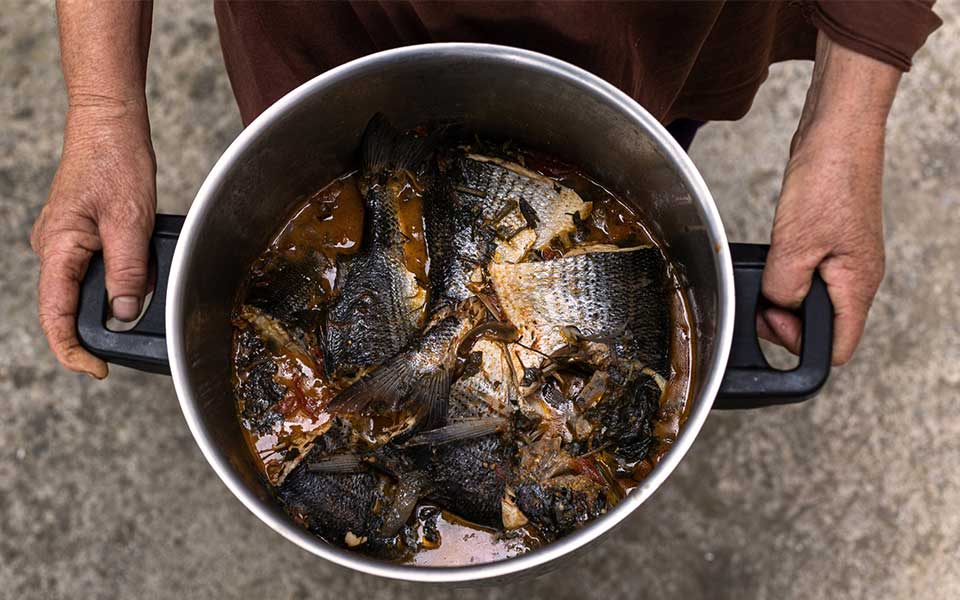
© Christina Georgiadou
“Once the village had three kafeneia, and all three were full every day; it was very lively,” said Lamprogiorgis. “I am the last one in the family to continue this work. My children have other jobs. They have studied and now live in the city. What should I say to them? ‘Leave everything and come to the village?’ Here, every year, incomes decrease; we produce less and less olive oil or cherries, which once provided good income.
However, people no longer work in agriculture; they leave for the city. The weather has also changed; there are constant disasters. The May rains rotted all the cherries on the trees; not a single one was left! Whatever we produce now is just enough for our own use.” A bitter smile remained on his lips but, remembering that he needed to bring us the rest of the meze, he got up and returned with sausages in one pan, potatoes in another ̶ the latter were local and hand-cut. Bent over the pans, he turned towards me. “How did you hear about the kafeneio?” he asked. When I explained that it was recommended to me by three good friends from Hania, enthusiasts and food lovers, he laughed and his face lit up. “Thank you, and thank them, too!”
This article was previously published in Greek at gastronomos.gr.

